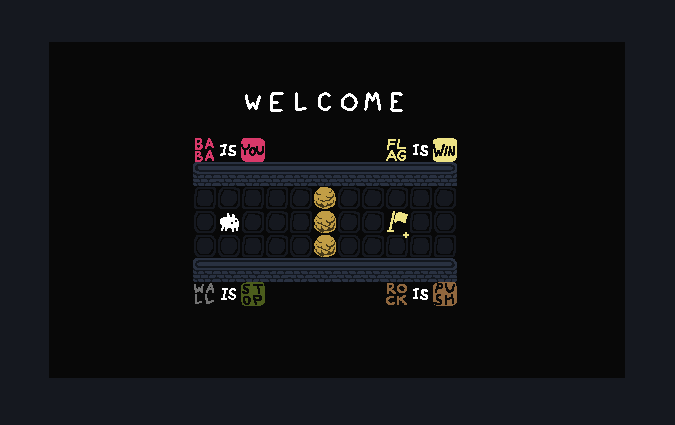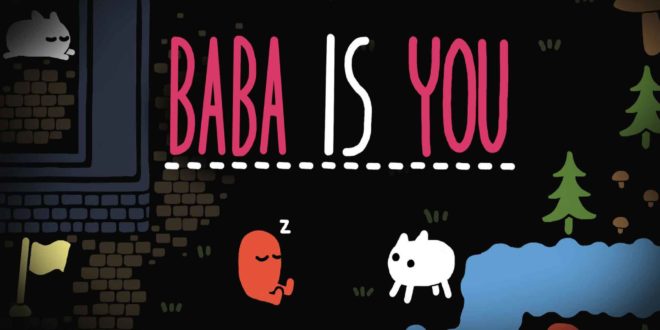Baba is You has taken to heart the old adage that all the best games are easy to learn and difficult to master.
Its concept is simple: the player must rearrange the game’s rules, which are physically written in the world, in order to solve puzzles and progress.
So if ‘Wall is Stop’ is written, you can physically move the word ‘Stop’ and you will then be able to walk through the wall, because it is not ‘Stop’ anymore. Most of the time, ‘Flag is Win’, so your objective is to reach the flag as protagonist Baba – hence the name Baba is You. However, throughout the game, you can pretty much be anything. All you have to do is push the right word in the right place and all of a sudden ‘Rock is You’, ‘Flag is You’ or even ‘Wall is You’.
Like many great games, Baba is You’s life started at a game jam, with Finnish developer Arvi ‘Hempuli’ Teikari building it for the 2017 Nordic Game Jam, which had the theme ‘Not There’.

“The theme gave me this idea of how the word ‘not’ works in certain situations like logic and programming, how you can take something, a concept, and invert its meaning. You can invert the meaning of a concept like ‘Baba’ by saying ‘not Baba’,” Teikari starts explaining. “I had been wanting to make a puzzle game for a very very long time. I had already made a bunch of mostly experimental, very short puzzle games. I had also been playing some really good turn-based, block pushing-based puzzle games, for example Stephan’s Sausage Roll, Snakebird and A Good Snowman is Hard to Build. And so the desire to make a puzzle game, inspiration from those other games and the ‘not something’ theme combined in my head randomly and I got this mental image of having a pool of lava that is hot and then having a block of ice that is… Well it’s ice,” he smiles. “And so the ice would melt if it comes close to the lava but then the player would be able to say that ‘Ice is not Melt’. So the ice would be safe. I started from that mental image and then I started brainstorming that concept a little bit and got the basic idea of the game.”
Baba is You has been incredibly successful since launch earlier this year, as it’s proven absolutely fascinating (and headache inducing at times!) to figure out how to change rules to reach the objective. However, Teikari initially had doubts about making it a full game as jam concepts don’t necessarily make good full-fledged titles.
“At game jams you make games that are very good for game jams: these short things that showcase a cool idea that surprises the player, that are often multiplayer so people can play them at the jam and have a good time together,” he reckons. “But then it’s very common for them to be difficult to expand into an experience outside of the game jam. With Baba is You, I felt that the game was very much about toying around with the words and having this sandboxy experience and I wasn’t sure if I would be able to deliver on that to make a fun game that is longer than just a short demo that explored this idea.”
“If you have a single developer making all the design decisions it’s very easy to become blind to the difficulty.”
At that point, Teikari had to make a decision: what kind of game was he trying to build with this concept?
“I felt immediately after the game jam that there was this conflict where I could either make a sandboxy, playful experience where the levels mostly just showcase cool things of the system and let you play around with them without much difficulty, or I could make a challenging puzzle game. It felt like the game might have that potential as well.”
Teikari chose the latter and graced us with one of the most challenging puzzle games in recent memory.
GAME IS HARD
Baba is You’s learning curve is steep – the early levels do a tremendous job at explaining the concept and learning about the different possibilities and options: things can be ‘Melt’, ‘Hot, ‘Sink’, ‘Defeat’, and many more, with the words ‘Not’ and ‘And’ also introduced quite early on to create longer statements. Then all of a sudden it feels like the game lets go of your hand and you’re all alone trying to figure things out – which is one of the many reasons why it’s brilliant.
But the sheer difficulty of the game was only partly a decision – and partly the result of developing the game on his own, Teikari says.
“I personally enjoy puzzle games that are very difficult. So I knew that if I wanted to make a serious puzzle game out of it, it would be fairly difficult. But as often happens if you have a single developer making all the design decisions it’s very easy for that designer to become blind to a lot of the difficulty.

“So even though there were several situations where I intentionally tried to make levels tricky, what ended up happening was that even things that I felt personally were too easy or too obvious mostly turned out to be very very difficult. That’s largely because the game requires you to take in quite a lot of information about the way it works.
“Even though the basic concept is simple – make rules, break rules – there’s a lot of underlying logic you have to understand. So throughout the development I actually had to adjust my expectations, adjust my thoughts, about the early levels especially, to make the game more approachable. I didn’t really want to make it a dark sort of puzzle game. I wanted it to be tricky at places but I wanted to make the game approachable even for players who just enjoy the idea and are not into really difficult puzzles. I feel that I failed in a sense, as the game is still considered extremely difficult.”
Teikari had a faithful group of beta testers who helped him have another perspective on the game and tweak its difficulty where needed. But he agrees that “the game could be even slower with increasing the difficulty.”
BREAKING THE LAW
Making a game that’s all about breaking and recreating rules led to some challenges in the development process too, Teikari continues.
“I think there were maybe two major things where that caused problems. First of all, the more fundamental of them is related to programming. I knew from the get go that I wanted to make the rule system very dynamic. In some interviews, people have asked me if I actually hardcoded all the different rule combinations, if the game code actually includes all different possibilities. But there are so many words in the game that it would be impossible,” Teikari says. “Despite that I wanted to make sure that if someone was to make their own levels in the game they could combine things pretty freely. And for the most part things would seem intuitive for the player.
“I had to rewrite quite big parts of the game code several times throughout development to make sure that some of the more meta things worked. Especially movement in the game is something that I had to come back into several times and it’s still not quite working because the game offers so many possibilities.
“The less fundamental thing is that because of the way the game works, the levels had very many unintended solutions. So when I went to testing the game I noticed that almost every single level I made had at least one alternative way to solve the level. This was not a problem in some cases, especially in the early levels – even the alternative solutions are interesting and surprising for the players because they haven’t seen that before. But there are some forms of alternative solutions that trivialise the level or you don’t really experience the twist of the level in an interesting way. So I’ve had to spend quite a lot of time changing the levels to make sure that even if the player finds an alternative solution, it still showcases the interesting bits of the level.”

Once again, that is where Teikari’s beta testers and their thorough feedback were very useful, finding out ways to finish levels that the developer didn’t realise were even possible.
“There are many variant levels that take a level and change a little part of it to make it harder… Many of those came to be because a tester found an alternative solution that I didn’t want to keep in the original level. But I liked it so much that I wanted to dedicate a new level to that solution alone,” he explains.
Watching streamers play the game after release also brought its fair share of surprises, from mysterious solutions to brand new interactions that even Teikari took a while to figure out how they were even possible, he tells us.
ALRIGHT THEN, KEEP YOUR SECRETS
Baba is You’s simple core concept hides layers upon layers of complexity. When you start playing it, it’s not long until you start questioning everything. For instance, there’s a level in the game’s Lake section where ‘Wall is Stop’ and ‘Wall is Defeat’ are part of the written rules. But the ‘Stop’ is overruling the ‘Defeat’: the player is not dying when running into a wall, which is the usual effect of the word ‘Defeat’. How Teikari decided what rule would take priority on the other (and how big a task that must have been considering the number of words in Baba is You) is something that literally kept me awake at night until this interview.
“That was probably the most complicated programming-related but also intuitiveness-related thing,” he answers. “Pretty quickly I realised that some of the rules have to work in slightly different ways or be active in slightly different ways.
“It’s such an underlying difficult to understand system, that I tried to implement the levels in such a way that the player doesn’t have to understand this.”
“The easiest way to explain some of those interactions is that there are two types of rules when it comes to objects interacting with each other. Some of them are things that happen when an object is trying to move onto a space with another object. So if you have Baba and a wall, some of the rules happen when Baba says: ‘Hey I want to move against that wall’. And then there are some other rules that activate when those two objects are already on top of each other.
“So ‘Stop’ is something that is checked when Baba is trying to move on top of the wall. So by necessity ‘Stop’ is checked first. So in the case you describe where ‘Wall is Stop’ and ‘Defeat’, if Baba was able to move on top of the wall, then Baba would be defeated. I think Baba never actually even moves on top of the wall because ‘Wall’ is already ‘Stop’ so that first attempt of movement fails and Baba is not defeated.”
The good thing though is that you don’t need to understand these rules to play Baba is You, as Teikari felt it was better to hide these layers of complexities to the player.

“This distinction between these two different rule types is something that I gave up even trying to convey to the player in a meaningful way,” he says. “It’s such an underlying difficult to understand system, that has certain corner cases, that I mostly tried to implement the levels in such a way that the player doesn’t have to understand this.”
Trying to understand it is still absolutely fascinating though, and is reminiscent of Cultist Simulator, with developer Alexis Kennedy having said that Weather Factory “wanted to make a game where understanding the game was itself the game.”
Teikari agrees that this reflects his approach to Baba is You too, to some extent, though that is inherent to any puzzle game, he reckons.
“Many parts of the game are about learning how the game works and many of the early levels are only difficult because you don’t yet understand how exactly things are going to work,” he says. “You have to experiment a little bit. A large part of learning how to play a puzzle game is firstly understanding what the mechanics are but also understanding how the developer thinks and how to approach the levels: what implicit rules does the game have?
“But then there’s this more underlying level of learning that I feel it’s made it better not to show to the player… Especially in a game like Baba where there’s so many different interactions going on all the time. After a certain point it maybe becomes a little bit less interesting to understand why something happens and more frustrating to have to keep in mind this very deep set of interactions and rules about those interactions. I tried to make Baba is You so that people could as often as possible trust their intuition about what should happen.”
DYSTOPIAN HELL WORLD
Teikari was still a student at the University of Helsinki when he took part in the Nordic Game Jam that led to Baba is You and its incredible success.
On top of being incredibly humble about it all, he’s also very aware of how lucky he was, which shows when we ask for advice for young developers balancing uni life and passion project.
“I often feel that if I give some advice and say: ‘Hey you should do this thing to make it in the games industry’, it’s kind of a lie because it might have worked for me because I live in a country with a good public health care system or I’ve never really been in poverty for example. So what has worked for me might not work for someone who has faced those situations.
“When I went from high school to university, I was really afraid of making games as a full-time job because I felt that the games industry was uncertain. I didn’t really want to be in a situation where I might make a game that doesn’t sell and then suddenly I don’t have any money and I don’t have any other skills to use to get revenue.
“I was afraid that making games as a full-time job would suck the fun out of it.”
“I was afraid that making games as a full-time job would also suck the fun out of it because suddenly I would have deadlines, I would actually have to finish those projects I had made for fun up until then.”
Following the release of his first commercial title Environmental Station Alpha in 2015, and having since become a full time developer, Teikari realised that his “fears from ten years ago were not as relevant as [he] thought them to be.”
However, he thinks that having an alternative to games dev as a career is still a good idea.
“I feel that there are many uncertainties and factors that could drastically change the industry in a very short amount of time. So if it’s at all possible I feel that it might be a smart idea to approach, at least at first, game development as something to do on your free time. Be prepared to use a plan B because it might happen.
“If I release a game in a dystopian hell world where people play games on analogue machines and then it makes no money and then I can’t live out of that, it’s something I want to keep in mind,” he concludes with a laugh.

 MCV/DEVELOP News, events, research and jobs from the games industry
MCV/DEVELOP News, events, research and jobs from the games industry




